A Spring Tour today in North Norfolk. It was rather cloudy in the morning, with a few light showers passing through, but brightened up with some nice sunny spells in the afternoon.
Our destination for the morning was Titchwell, but on the way there we stopped to avoid a Grey Wagtail in the road, near the old Burnham Overy water mill. It quickly flew up onto the edge of the roof of one of the cottages nearby, which allowed us to drive on past.
When we arrived at Titchwell we could hear a Turtle Dove purring from deep in a leafy sycamore next to the car park. We had a look to see if we could see it, but it was clearly tucked in out of sight. A smart male Greenfinch was more obliging, wheezing from the trees next to the car. A Red Kite drifted over head.
At that point, one of the reserve volunteers came over to tell us that a Wood Warbler was singing by the visitor centre and a Spotted Flycatcher had been seen around the picnic area. Wood Warbler is a very scarce visitor here, so we hurried along to see if we could find it. We heard it singing as we walked along and came across a small crowd looking up into the trees along the entrance road. We got great views of the Wood Warbler as it flitted around in an oak, stopping every few seconds to sing, before it moved off quickly further up the line of trees out of sight.
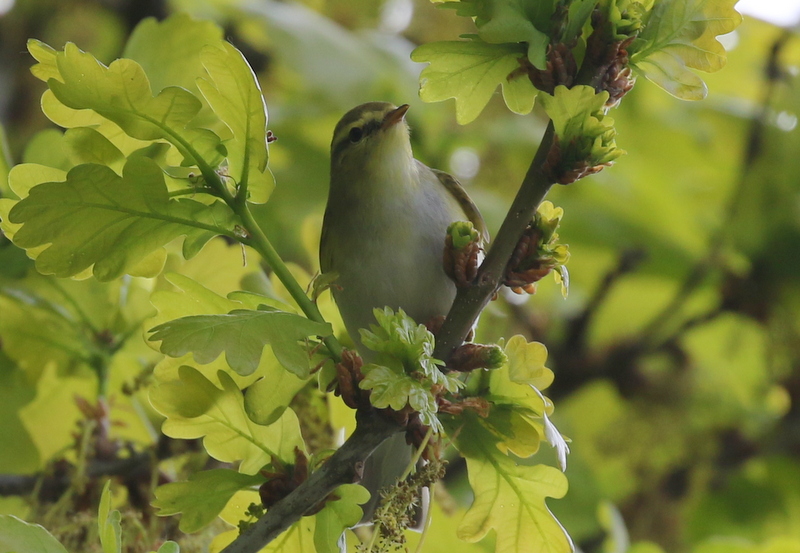 Wood Warbler – singing in the trees along the access road this morning
Wood Warbler – singing in the trees along the access road this morning
Having had a good look at the Wood Warbler, we made our way back to the picnic area to see if we could find the Spotted Flycatcher. We waited here a few minutes, scanning the trees, but there was no more sign of it. Another favoured area for them here is the pool along Fen Trail, so we walked round to see if it might be there. It wasn’t, but we did get a nice look at a Reed Warbler hopping about in the reeds here.
The Turtle Doves had apparently been visible in the trees behind Fen Hide earlier, so we made our way along to there next. There was no sign of them at first, but as a brief shower passed over, we took shelter in the hide. A pair of Common Pochard were diving on the edge of the reeds. A Cetti’s Warbler flew low across the pool and dropped down into the base of a bush. We came out again, just in time to see a pair of Turtle Doves fly over and circle round in front of us before dropping back down into the trees.
On our way to Patsy’s Reedbed, we stopped to look at a Bloody-nosed Beetle walking along the boardwalk. There were several around the paths today – both live ones and a couple which had been crushed underfoot. A Common Whitethroat was singing in the brambles.
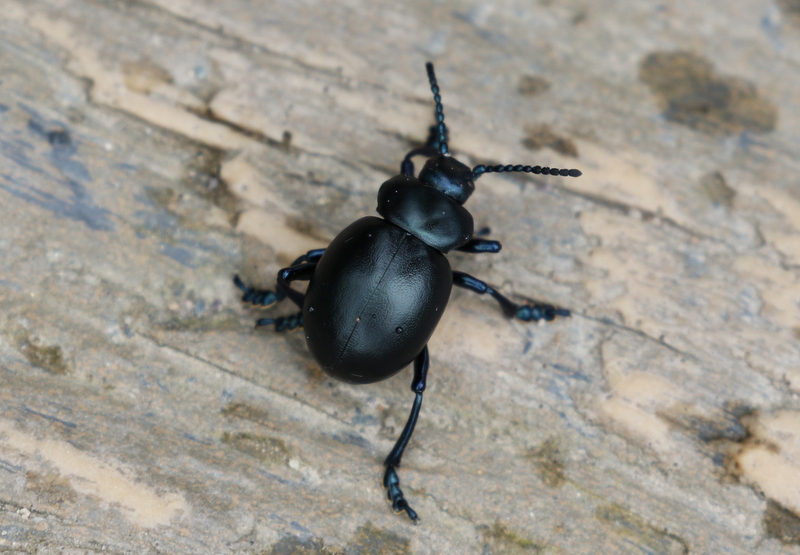 Bloody-nosed Beetle – commonly seen around the paths on the reserve
Bloody-nosed Beetle – commonly seen around the paths on the reserve
At Patsy’s Reeded, we quickly located a single drake Red-crested Pochard asleep on the bank with a couple of Tufted Ducks. A pair of Little Grebes were diving out in the middle. A couple of Marsh Harriers circled over the reedbed and dropped down into the reeds out of view. There were good numbers of Swifts swooping for insects over the water.
 Red-crested Pochard – this drake was asleep on Patsy’s Reedbed
Red-crested Pochard – this drake was asleep on Patsy’s Reedbed
We made our way back and round via the Meadow Trail out to the main path. The former pool on the Thornham grazing marsh is now looking very dry and uninviting, so we focused our attention on the reedbed. There were lots of warblers singing today – Reed Warblers and Sedge Warblers, and the odd Cetti’s Warbler shouting at us occasionally from the bushes. A male Reed Bunting showed very well by the pools.
Something on the path seemed to be causing a stir amongst the people ahead of us, and we walked over to see a Common Shrew running along the edge of the path. Unfortunately, it didn’t look well. It was missing some fur from the back of its neck, so perhaps something had had a go at it. A Mediterranean Gull flew over calling. A Cuckoo shot over the path and headed out over the saltmarsh.
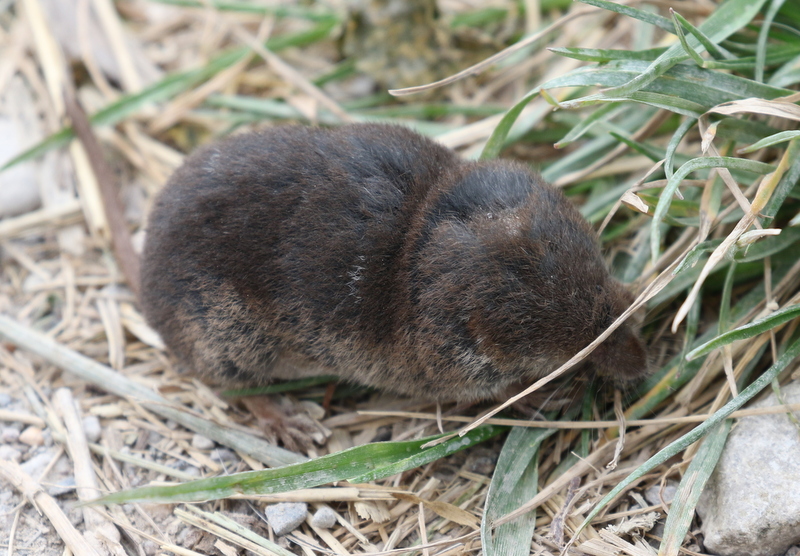 Common Shrew – was running along the edge of the main path
Common Shrew – was running along the edge of the main path
At this point, it started to rain again, so we hurried on towards the shelter of Island Hide. A Grey Plover on the saltmarsh pool opposite was looking smart with its summer black face and belly.
The water levels have started to drop a bit on the freshmarsh now, and there were a few more waders on here today. Our main target here was a Little Stint which had been reported earlier and we quickly located it on one of the islands. We could see how small it was – creeping around on the mud, next to the much larger ducks. It was very flighty though, and kept flying round before coming back to the islands. Migrant waders at this time of year are often in a hurry to get on their way. We could also see a couple of Little Ringed Plovers, way over the other side, close to Parrinder Hide.
There is rarely any shortage of Avocets here, and we had some nice views of them feeding in front of the hide. There were also good numbers of Black-tailed Godwits back on here again. Presumably they are mostly young birds, born last year, which will not breed or migrate to Iceland this year. They also don’t moult fully into breeding plumage – most were still in their winter greys, but a few had a scattering of orange feathers. A single Ruff was on the mud close to the hide – also not yet in full breeding plumage, but starting to moult its head and neck.
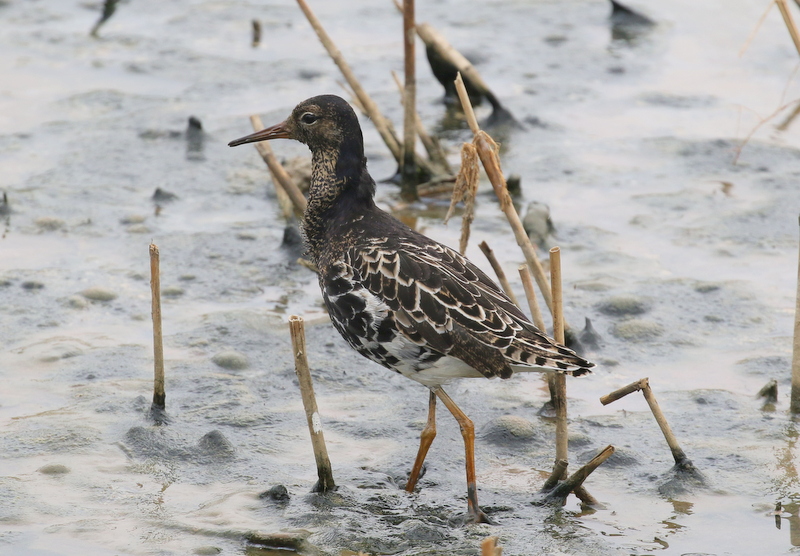 Ruff – starting to get some summer feathers on head and neck
Ruff – starting to get some summer feathers on head and neck
There are several Common Terns around the freshmarsh now, which are always nice to see. Through the scope, we could see their black-tipped red bills and red legs. There were also three Sandwich Terns on here today, including a pair mating. Presumably they will be looking to nest in the colony on nearby Scolt Head. There is a large Black-headed Gull colony on the fenced off Avocet island and in among them are several pairs of Mediterranean Gulls. We picked one out with the scope – its much blacker head and bright red bill standing out even at a distance.
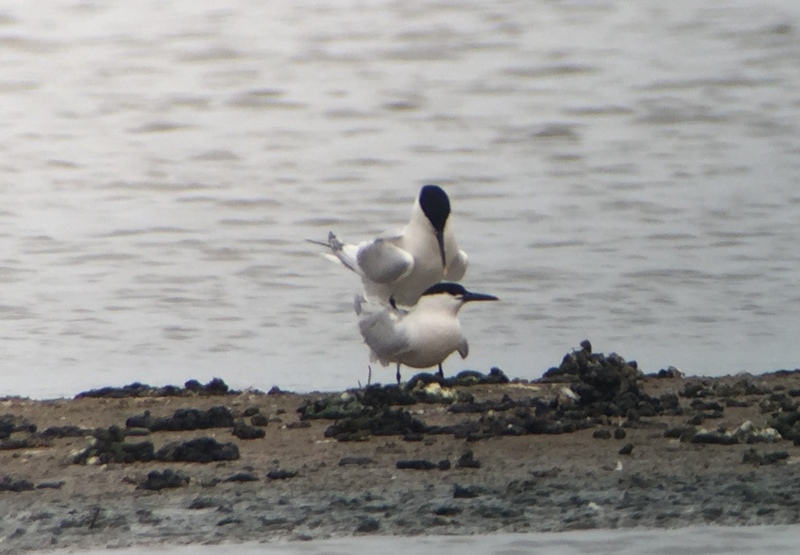 Sandwich Terns – this pair were mating on the freshmarsh today
Sandwich Terns – this pair were mating on the freshmarsh today
There are not so many ducks around the freshmarsh now. In particular, the number of Teal have finally dropped as birds have departed on their journey north to breed. We still found a single pair of Teal here today. There are still good numbers of Gadwall and Mallard and lots of Shelduck, all of which breed here. We stopped to admire a drake Gadwall – not the gaudiest of ducks, rather grey and black, but a wonderfully subtle mix of patterns. The Brent Geese have not all departed for Russia yet, and a small group came onto the freshmarsh to bathe.
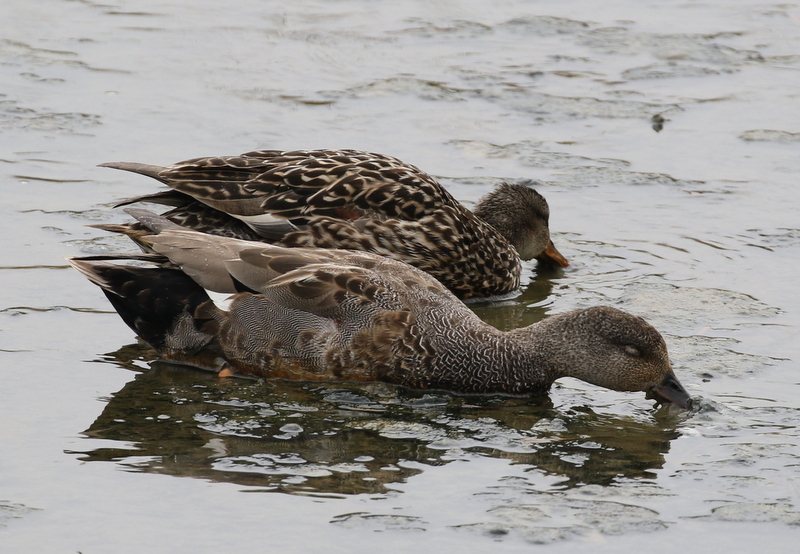 Gadwall – with intricately patterned feathers
Gadwall – with intricately patterned feathers
By the time we got round to Parrinder Hide, the Little Stint had disappeared. We did get closer views of the Little Ringed Plovers through the scope, so we could see their golden yellow eye rings. However, it was the baby Avocets which drew the most attention. Like little balls of fur, with long legs and a little upturned bill. Two females had one chick each today, and one of them was feeding quite close to the hide. The adult Avocets are not the most attentive parents and as the young ones wandered away, it seemed no surprise that they are very vulnerable to predation.
 Avocet – a small chick was feeding in front of Parrinder Hide
Avocet – a small chick was feeding in front of Parrinder Hide
The weather had improved now, so we decided to make a quick dash out to the beach. There was not much to see on the Volunteer Marsh today – a drake Shoveler close to the path and several Avocets feeding along the channel at the far end. The Tidal Pools were also rather quiet, apart from a single Bar-tailed Godwit. We got it in the scope and talked about the differences between Bar-tailed Godwit and the Black-tailed Godwits we had seen earlier on the Freshmarsh.
As we walked up over the dunes, we could see a couple of groups of black ducks flying round over the sea beyond. From the beach, we got them in the scope and could see they were mostly Common Scoter. Looking carefully through them, we picked out two or three Velvet Scoters too, getting a flash of the white in their wings as they flapped or seeing the white diagonal line on their sides. There was also still a singe Red-breasted Merganser offshore.
There were a few waders still distantly out on the mussel beds, despite the rising tide. As well as lots of Oystercatchers and several more Bar-tailed Godwits, we found a little group of Sanderling and Turnstone, both coming into summer plumage now. A small flock of Knot flew off along the shoreline. At that point we noticed some dark cloud approaching fast behind us. It started to rain, but thankfully it was just a few spits and spots.
Once the rain stopped, we decided to make our way back for lunch. There were two or three Little Egrets out on the saltmarsh, but when a larger white bird took off, a quick look at it confirmed it was a Spoonbill. It circled round and landed back down in one of the channels on the saltmarsh out of view. A Grey Heron was more obliging. It flew in to the pools right by the main path, causing a female Mallard to leave her brood of ducklings and chase after it. The Grey Heron didn’t seem too fussed and landed on the edge of the reeds where it started to preen.
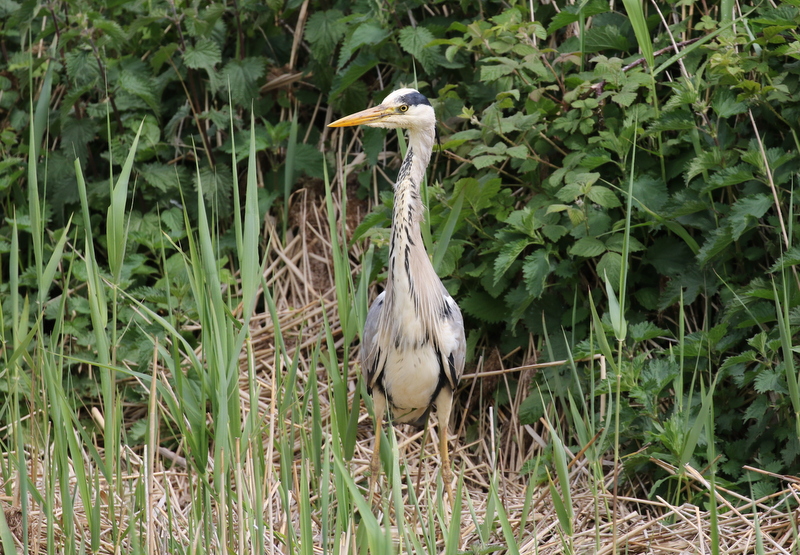 Grey Heron – stood preening on the edge of the reeds
Grey Heron – stood preening on the edge of the reeds
With the skies brightening up nicely now, we ate our lunch in the picnic area. There was still no sign of any Spotted Flycatchers here, but a Goldcrest showed well in the pine trees. We could still hear the Wood Warbler singing, back towards the car park, and after lunch we walked to the car to find it in the oak tree just above! We had another nice look at it before it flew back deeper into the trees.
The Turtle Dove was still purring from the leafy sycamore and helpfully waited until we had packed the scope away before flying out and across to a bare tree where we could finally get a good look at it. By the time we got the scope out again and set up, needless to say it flew back to the sycamore out of view!
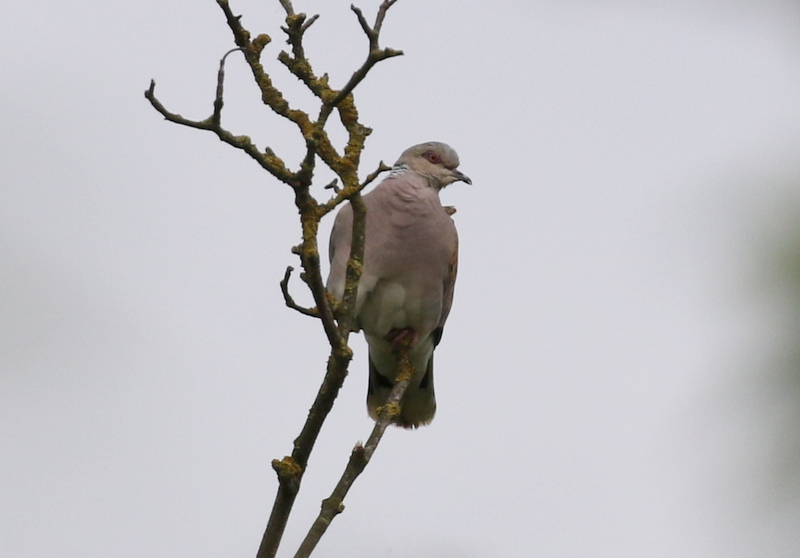 Turtle Dove – finally showed itself briefly in a bare tree in the car park
Turtle Dove – finally showed itself briefly in a bare tree in the car park
While we were at Titchwell, reports had come through of a trip of Dotterel in a field just up the road at Choseley, so we drove up there for a look. We found a few people standing in the entrance to a field, who showed us where the birds were, but they were miles away. The bare stoney field was picking up the heat from the sun, resulting in a lot of shimmer, so that even with the scope we couldn’t make out much more than a few small blurry shapes.
We decided to head down the footpath to try to find a vantage point a little closer to them, but some people coming back the other way explained that because of a ridge in the field, the Dotterel were not visible from along there. We carried on anyway, reasoning that they were moving round the field, but when we got to the end we found they were right. A Yellowhammer was singing in the hedge nearby.
It looked like it was back to Plan A, distant views from back at the road, but as we walked back we scanned the field just in case. Bingo! Just at that point, the Dotterel appeared over the ridge across the field in front of us. We all had a great look at them through the scope, just in time before they sat down just over the ridge – we could just see the tops of a couple of their heads!
 Dotterel – a quick record shot of one before they all sat down
Dotterel – a quick record shot of one before they all sat down
On the way back, we just had time for a short stop at Holkham and a quick walk down to the hides. It was sunny now and in the heat of the afternoon, there were still a few warblers singing on the walk out, Blackcaps and Chiffchaffs, plus the regular Coal Tits, Treecreeper and Goldcrest.
We stopped to scan the grazing marshes just before Washington Hide and spotted a large white shape out on one of the pools. It was a Spoonbill, dropped in to bathe on its way back to the colony. We got it in the scope and could see its bushy crest blowing in the wind. A second Spoonbill appeared and started preening nearby, before the first flew off back towards the trees.
From up in the Joe Jordan Hide, there was a steady coming and going of Spoonbills, Little Egrets and Cormorants to and from the trees. One or two Spoonbills came down repeatedly to collect vegetation from the edge of the pool for their nests and a little group gathered half hidden behind the rushes at the front to bathe.
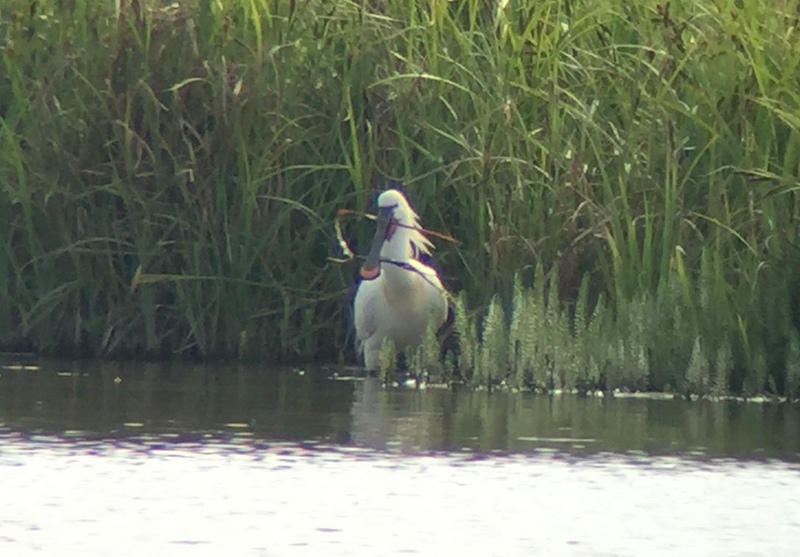 Spoonbill – collecting nest material from the edge of the pool
Spoonbill – collecting nest material from the edge of the pool
It was a nice way to finish the day here. As well as all the activity around the trees, we could see several Marsh Harriers and Common Buzzards out over the grazing marshes. A Hobby was catching insects rather distantly away to the west. The one thing we hadn’t seen here today was one of the Great White Egrets, but just as we were thinking about heading back one flew up out of the reeds and circled round before disappearing behind the wood. With that one to wrap things up nicely, we walked back to the car, with a Jay on the way to round off the day’s list.
















